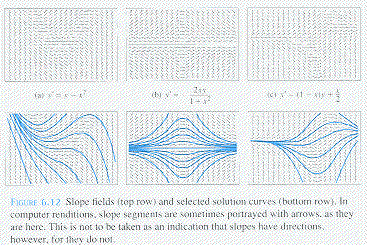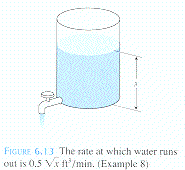Slope Fields:Viewing Solution Curves
Examples of Differential Equations
in Applications:
Law of Exponential Change
Continuously Compounded Interest
Radioactivity
Heat Transfer: Newton's Law of Cooling
Resistance Proportional to Velocity
Torricelli's Law
First-Order Separable Differential Equations
A first-order linear equation
is separable if
and a function of
In other words, the equation has the form
If
both sides by
Integrate both sides
or
With the
and the other on the other side, we integrate and complete
the solution. That is the basic process for solving a separable
linear first-order differential equation.
See Example 2, pages 486 - 487.
Slope Fields: Viewing Solution Curves
Because the general solution of the differential equation
contains an arbitrary constant, the graph of the solution
consists of an infinite of curves.
Graphing the equation
directly associates to each point (within the domain of
Such a graph is called a Slope Field.

Examples of Differential Equations in Applications
Law of Exponential Change
Examples of phenomena where a quantity
at a rate proportional to the amount present are population, radioactive
decay, continuously compounded interest, and heat transfer.
The phenomena may be represented mathematically by the
differential equation
with the initial condition
The derivative is taken with respect to time
The solution of the initial value problem is
where
The number
is the rate constant of the equation which characterizes
the specific context of the phenomenon in question.
Continuously Compounded Interest
Suppose
dollars are invested in an account in which the interest is added continuously
- that is, at every moment of time, not just annually or quarterly -
then we can model the growth of the account with the initial value problem
whose solution is
The number
is the continuous interest rate.
See Example 3, page 489.
Radioactivity
The decay of a radioactive element is described by
The amount still present at at a later time
The half-life of a radioactive element is the time required for half
of the radioactive nuclei present in a sample to decay.
See Examples 4 - 5, pages 489 - 491.
Heat Transfer: Newton's Law of Cooling
Study a heated object immersed in a cooler surrounding medium.
The object, in time, will cool down to the temperature of the surrounding
medium and the differential equation describing this process is
where
is the temperature of the object at time
and
is the constant surrounding temperature.
If we let
the above equation becomes
We have seen this basic equation many times before!
Its solution is
where
and
Returning to the original symbols, Newton's Law of Cooling is then
See Example 6, pages 491 - 492.
Resistance Proportional to Velocity
Imagine an object of mass
position and velocity at time
By one of Newton's Laws of Motion
Force = mass times acceleration
the force resisting the motion can be written as
The condition that the resisting force is proportional to the velocity
can be written as
or
If the sign in the differential equation were positive instead of negative,
the force would be assisting the motion, not resisting it.
Its solution with initial condition
is
See A Moving Body Coasting to a Stop and Example 7, pages 493 - 494.
Torricelli's Law
If you drain a tank like the one pictured below, the rate at which
the water runs out is a constant times the square root of the water's depth
The constant depends on the size of the exit value.

See Example 8, pages 494 - 495.
next Linear First-Order Differential Equations
Top